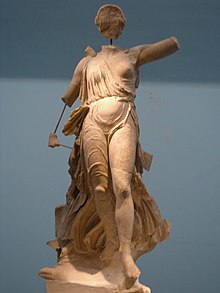
Back Пеоний Мендски Bulgarian Peoni de Mende Catalan Paión z Mendé Czech Paionios (Bildhauer) German Παιώνιος Greek Peonio de Mende Spanish Paionios Mendeläinen Finnish Paionios French Paióniosz (szobrász) Hungarian Peonio di Mende Italian
This article needs additional citations for verification. (June 2013) |

Paeonius /piːˈoʊniəs/ (Greek: Παιώνιος Paiṓnios) of Mende, Chalkidiki was a Greek sculptor of the late 5th century BC. He most likely received his early training in Northern Greece and is thought to have later adapted Athenian stylistic elements into his own work, based upon his probable interaction with the Olympia workshop of Phidias.[1] In any case, he was "attic-trained."[2]
Paeonius won the commission to decorate the acroteria of the Temple of Zeus at Olympia, as described in the pedestal inscription on his Nike statue. An ancient account also references Paeonius' work at Olympia. Pausanias attributes the front (east) pedimental sculptures of the Temple of Olympian Zeus to Paeonius. The Nike Temple parapet at Athens is also often attributed to Paeonius, on the basis of similarities between the styles of drapery on both monuments.[3] Despite this assertion, scholars continue to debate the reliability of these attributions based upon the various interpretations of the scant additional evidence.
The Nike of Paionios featured prominently in the design of medals of the 2004 Summer Olympics in Athens, as it did in the design of medals from succeeding Olympiads. The statue likely influenced later artistic renderings of victory personified. It is on permanent exhibition at the Archaeological Museum of Olympia.
© MMXXIII Rich X Search. We shall prevail. All rights reserved. Rich X Search